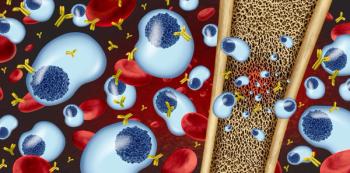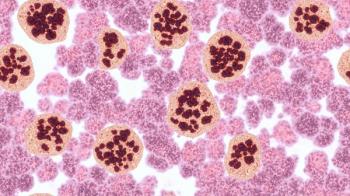
Novel Radioactive Tracer Could Predict Response to Lung Cancer Drugs
A PET scan could quickly indicate whether EGRF-targeted therapy would be beneficial to patients with non-small cell lung cancer.
The efficacy of cancer treatment can vary greatly based on disease stage, previous therapies, and genetics. These variations can be the difference between achieving remission and disease progression, making cancer treatment decisions crucial to optimal outcomes. Currently, cancer treatment is largely based on patient factors and oncologist opinions as opposed to a more scientifically-guided strategy.
However, a new study published by Science Translational Medicine suggests that an imaging agent and an imaging scan could determine the optimal treatment for lung cancer.
The researchers formulated a PET scan-compatible agent, called F-MPG, that can target a common mutation in non-small cell lung cancer. Once detected, the agent binds to the mutation and emits a radioactive signal, according to the study.
The authors said that F-MPG not only uncovers the drivers of the tumor, but also pinpoints vulnerabilities in the cancer where targeted treatments can be used to block growth.
“Some people wonder, ‘Can’t you just prescribe the drug and wait to see if the tumor shrinks? If it shrinks, then you know it’s working,’” said researcher Sanjiv Gambhir, MD, PhD.
Although this perception is true, if treatment is not effective, tumors can grow and mutate further, which makes them more difficult to treat, according to the authors.
“In the time you waited to see if the tumors shrank, those tumors continued to evolve, and that makes it more difficult to treat with the next round of therapy,” Dr Gambhir said.
In situations such as this, a quick PET scan could identify patients whose tumors likely do not harbor the mutation due to a lack of radioactive signaling, meaning that treatment won’t be effective, according to the study.
PET scans and various types of imaging agents are commonly used to identify different types of diseases.
“There are hundreds of drugs, just like there are hundreds of imaging agents; we have to keep building new ones for different purposes,” Dr Gambhir said. “We have to keep looking for different ways to interrogate the underlying biology of the tumor, and the new method we’ve developed goes after actually measuring mutations in the tumor.”
F-MPG can accurately identify whether tumor cells are present and whether they contain a mutated version of epidermal growth factor (EGFR), according to the study.
Related Coverage:
“If the PET scan shows a high signal from the tracer in a patient’s lung cancer, that’s predictive of someone who is going to respond well to the specific epidermal growth factor therapy,” Dr Gambhir said. “For those who show low signals, they’re likely not going to respond, so you need to look into other treatment options.”
The authors noted that an alternative approach to testing for the mutation is biopsy, which may not be accurate due to multiple variations in a single tumor.
“One way to think about this imaging technique is like it’s taking a biopsy of the entire body, and that gives a much more complete picture of the mutational status of the primary tumor, which allows you much better information to treat the cancer,” Dr Gambhir said.
In a clinical trial, the authors discovered that more than 80% of patients who had EGFR mutations as indicated by the tracer responded to a targeted drug compared with only 6% of patients who lacked evidence of the mutation.
Next, the researchers plan to conduct a larger clinical trial and, upon positive results, hope the tracer will be used in a clinical setting.
Newsletter
Stay informed on drug updates, treatment guidelines, and pharmacy practice trends—subscribe to Pharmacy Times for weekly clinical insights.




















































































































































































































